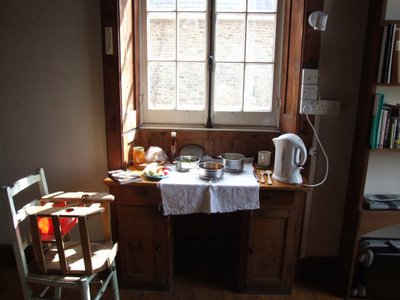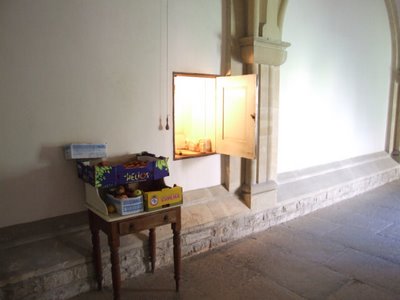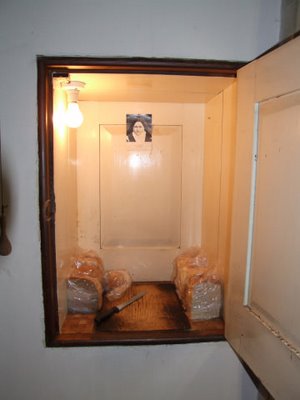Food at Parkminster
The Conventual Mass at St Hugh's is at 8.15am during the week. Afterwards, I followed the custom of celebrating a private Mass as the Carthusian priests do every day. More about that later. After this and thanksgiving, the first period of manual work or study begins at 10.30am. At 11.15am, the monks say the office of Sext and then lunch arrives delivered by trolley around the cloister and placed into the hatch of each cell.
Here is the lunch as it is delivered. The can on top is fresh milk. There are three trays with food in, a fruit basket and your preference of drink:
 The meal is taken at a shelf in the window recess, called the Refectorium. There is a personal tablecloth, a metal knife and a wooden fork and spoon to eat it with.
The meal is taken at a shelf in the window recess, called the Refectorium. There is a personal tablecloth, a metal knife and a wooden fork and spoon to eat it with.
 To drink, there is a choice of fruit juice or Parkminster's home-made apple wine. It sometimes gets called cider but apple wine is probably a safer name because it is 10% abv. It is quite dry and decepively strong. I had this for the first two days then asked for orange juice because the wine made it difficult to stay awake during Vespers.
To drink, there is a choice of fruit juice or Parkminster's home-made apple wine. It sometimes gets called cider but apple wine is probably a safer name because it is 10% abv. It is quite dry and decepively strong. I had this for the first two days then asked for orange juice because the wine made it difficult to stay awake during Vespers.
Here is one day's meal: a dish of sardines with some spicy sauce, a dish of fresh vegetables and a dish of mushroom soup. There is always plenty of fruit and bread. The dish of vegetables and the basket of fruit is constant. The hot dish varies and can be fish, eggs, a vegetarian pasty or something else (never any meat). Instead of soup, there is often cereal.
 The diet is probably as healthy as it is possible to be - the monks had this worked out long before modern nutritionists. I found that there was plenty to eat although to be fair, I did not do as much manual work as most of the monks and therefore did not need to eat as much. They look pretty fit physically and some quite elderly men seemed to thrive on heavy labour in the "obediences" which is the name given to the areas where the vegetables and fruit are grown, the wood is chopped and other manual tasks are undertaken. Traditionally this area is for the Brothers to work in but the Choir Monks also work there if it is conisidered suitable.
The diet is probably as healthy as it is possible to be - the monks had this worked out long before modern nutritionists. I found that there was plenty to eat although to be fair, I did not do as much manual work as most of the monks and therefore did not need to eat as much. They look pretty fit physically and some quite elderly men seemed to thrive on heavy labour in the "obediences" which is the name given to the areas where the vegetables and fruit are grown, the wood is chopped and other manual tasks are undertaken. Traditionally this area is for the Brothers to work in but the Choir Monks also work there if it is conisidered suitable.
From Easter until September, a second light meal is delivered after Vespers: one dish of eggs or something like that. From the feast of the Exaltation of the Holy Cross until Easter, there is the "Great Fast" when this meal is omitted. On Fridays the monks fast on bread and water. On some days such as vigils, they abstain from lacticinia - any products of milk or eggs. However it is always possible to get bread or fruit from the cloister near the chapel:
 The bread hatch lights up automatically when you open the door. The picture of St Thérèse of Lisieux shows that even very simple things can be an occasion of prayer.
The bread hatch lights up automatically when you open the door. The picture of St Thérèse of Lisieux shows that even very simple things can be an occasion of prayer.

Here is the lunch as it is delivered. The can on top is fresh milk. There are three trays with food in, a fruit basket and your preference of drink:
 The meal is taken at a shelf in the window recess, called the Refectorium. There is a personal tablecloth, a metal knife and a wooden fork and spoon to eat it with.
The meal is taken at a shelf in the window recess, called the Refectorium. There is a personal tablecloth, a metal knife and a wooden fork and spoon to eat it with. To drink, there is a choice of fruit juice or Parkminster's home-made apple wine. It sometimes gets called cider but apple wine is probably a safer name because it is 10% abv. It is quite dry and decepively strong. I had this for the first two days then asked for orange juice because the wine made it difficult to stay awake during Vespers.
To drink, there is a choice of fruit juice or Parkminster's home-made apple wine. It sometimes gets called cider but apple wine is probably a safer name because it is 10% abv. It is quite dry and decepively strong. I had this for the first two days then asked for orange juice because the wine made it difficult to stay awake during Vespers.Here is one day's meal: a dish of sardines with some spicy sauce, a dish of fresh vegetables and a dish of mushroom soup. There is always plenty of fruit and bread. The dish of vegetables and the basket of fruit is constant. The hot dish varies and can be fish, eggs, a vegetarian pasty or something else (never any meat). Instead of soup, there is often cereal.
 The diet is probably as healthy as it is possible to be - the monks had this worked out long before modern nutritionists. I found that there was plenty to eat although to be fair, I did not do as much manual work as most of the monks and therefore did not need to eat as much. They look pretty fit physically and some quite elderly men seemed to thrive on heavy labour in the "obediences" which is the name given to the areas where the vegetables and fruit are grown, the wood is chopped and other manual tasks are undertaken. Traditionally this area is for the Brothers to work in but the Choir Monks also work there if it is conisidered suitable.
The diet is probably as healthy as it is possible to be - the monks had this worked out long before modern nutritionists. I found that there was plenty to eat although to be fair, I did not do as much manual work as most of the monks and therefore did not need to eat as much. They look pretty fit physically and some quite elderly men seemed to thrive on heavy labour in the "obediences" which is the name given to the areas where the vegetables and fruit are grown, the wood is chopped and other manual tasks are undertaken. Traditionally this area is for the Brothers to work in but the Choir Monks also work there if it is conisidered suitable.From Easter until September, a second light meal is delivered after Vespers: one dish of eggs or something like that. From the feast of the Exaltation of the Holy Cross until Easter, there is the "Great Fast" when this meal is omitted. On Fridays the monks fast on bread and water. On some days such as vigils, they abstain from lacticinia - any products of milk or eggs. However it is always possible to get bread or fruit from the cloister near the chapel:
 The bread hatch lights up automatically when you open the door. The picture of St Thérèse of Lisieux shows that even very simple things can be an occasion of prayer.
The bread hatch lights up automatically when you open the door. The picture of St Thérèse of Lisieux shows that even very simple things can be an occasion of prayer.
